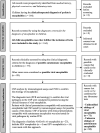In Children, N-Methyl-D-Aspartate Receptor Antibody Encephalitis Incidence Exceeds That of Japanese Encephalitis in Vietnam
- PMID: 39691294
- PMCID: PMC11651147
- DOI: 10.1093/ofid/ofae710
In Children, N-Methyl-D-Aspartate Receptor Antibody Encephalitis Incidence Exceeds That of Japanese Encephalitis in Vietnam
Abstract
Background: The recognition of autoimmune causes of encephalitis has led to epidemiological shifts in the worldwide characteristics of encephalitis. N-methyl-D-aspartate receptor (NMDAR) antibody encephalitis leads to well-established complex neuropsychiatric manifestations. In low- and middle-income countries, including Vietnam, its relative incidence, especially in children, is unknown and most neurologists currently consider infectious encephalitis prior to autoimmune etiologies.
Methods: The study was prospectively conducted at Children's Hospital 1 in Ho Chi Minh City between March 2020 and December 2022. Any child admitted to the Department of Infectious Diseases and Neurology fulfilling the case definition of encephalitis was eligible to participate. Cerebrospinal fluid samples were collected alongside meta-clinical data for analysis.
Results: We recruited 164 children with a clinical diagnosis of encephalitis. Etiologies were determined as NMDAR antibody encephalitis in 23 of 164 cases (14.0%), Japanese encephalitis virus in 14 of 164 (8.5%), and herpes simplex virus in 4 of 164 (2.4%). Clinical categorizations suggested idiopathic viral encephalitis in another 71 (43.3%), and autoimmune encephalitis of unknown origin in the remaining 52. Factors including demographics, specific clinical features, cerebrospinal fluid and electroencephalogram findings, and length of hospital stay were significantly different between NMDAR antibody encephalitis and Japanese encephalitis.
Conclusions: At a tertiary children's hospital in Vietnam, the prevalence of NMDAR antibody encephalitis exceeds that of Japanese encephalitis, the most common infectious encephalitis cause in Southeast Asia. NMDAR antibody encephalitis is associated with long hospital stay and poor outcomes. These findings should change pediatric diagnostics, to earlier consider autoimmune treatments in this clinical setting.
Keywords: Japanese encephalitis virus; N-methyl-D-aspartate receptor antibody encephalitis; children; encephalitis; herpes simplex virus.
© The Author(s) 2024. Published by Oxford University Press on behalf of Infectious Diseases Society of America.
Conflict of interest statement
Potential conflicts of interest. S. R. I. has received honoraria/research support from UCB, Immunovant, MedImmun, Roche, Janssen, Cerebral Therapeutics, ADC Therapeutics, BioHaven Therapeutics, CSL Behring, and ONO Pharma; receives licensed royalties on patent application WO/2010/046716 entitled “Neurological Autoimmune Disorders”; and has filed 2 other patents entitled “Diagnostic method and therapy” (WO2019211633 and US application 17/051,930; PCT application WO202189788A1) and “Biomarkers” (WO202189788A1, US application 18/279,624; PCT/GB2022/050614). All other authors report no potential conflicts.
Figures



Similar articles
-
Frequency, symptoms, risk factors, and outcomes of autoimmune encephalitis after herpes simplex encephalitis: a prospective observational study and retrospective analysis.Lancet Neurol. 2018 Sep;17(9):760-772. doi: 10.1016/S1474-4422(18)30244-8. Epub 2018 Jul 23. Lancet Neurol. 2018. PMID: 30049614 Free PMC article.
-
[N-methyl-D-aspartate receptor antibody encephalitis: the Janus-faced disorder].Neuropsychopharmacol Hung. 2018 Mar;20(1):18-25. Neuropsychopharmacol Hung. 2018. PMID: 29790849 Hungarian.
-
Clinical and EEG characteristics analysis of autoimmune encephalitis in children with positive and negative anti-N-methyl- D-aspartate receptor antibodies.Ann Palliat Med. 2020 Sep;9(5):2575-2585. doi: 10.21037/apm-19-484. Epub 2020 Aug 27. Ann Palliat Med. 2020. PMID: 32921070
-
[Diagnosis and differential diagnosis of anti-N-methyl-D-aspartate receptor encephalitis in children].Zhongguo Dang Dai Er Ke Za Zhi. 2014 Jun;16(6):578-83. Zhongguo Dang Dai Er Ke Za Zhi. 2014. PMID: 24927431 Review. Chinese.
-
The psychopathology of NMDAR-antibody encephalitis in adults: a systematic review and phenotypic analysis of individual patient data.Lancet Psychiatry. 2019 Mar;6(3):235-246. doi: 10.1016/S2215-0366(19)30001-X. Epub 2019 Feb 11. Lancet Psychiatry. 2019. PMID: 30765329 Free PMC article.
References
-
- Whitley RJ, Gnann JW. Viral encephalitis: familiar infections and emerging pathogens. Lancet 2002; 359:507–13. - PubMed
-
- Granerod J, Ambrose HE, Davies NW, et al. Causes of encephalitis and differences in their clinical presentations in England: a multicentre, population-based prospective study. Lancet Infect Dis 2010; 10:835–44. - PubMed
Grants and funding
LinkOut - more resources
Full Text Sources

